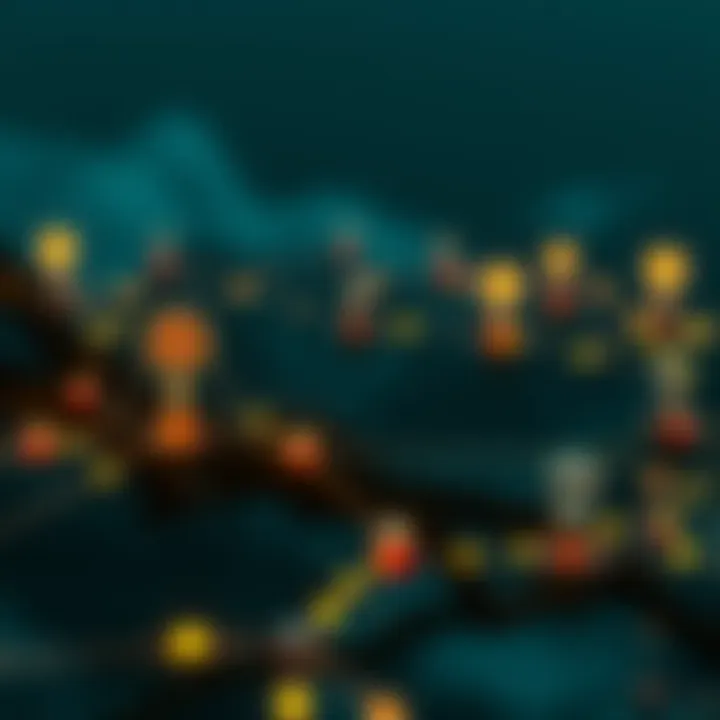Exploring Oracles in Cryptocurrency Ecosystems


Intro
In the fast-evolving world of cryptocurrency, where innovation and technology seem to grow at the speed of light, one component stands out as crucial yet often misunderstood: oracles. These intermediaries act as bridges, connecting the insular realm of blockchain with the bustling world of real-time data, creating a vital link for the functioning of smart contracts. Without oracles, many applications in the decentralized finance (DeFi) sector wouldn't be feasible, potentially stifling growth and advancement.
Understanding the role of oracles can be instrumental for anyone navigating the murky waters of cryptocurrency. This article is designed not just for the seasoned trader who can recite market statistics but also for the curious tech enthusiast, students eager to grasp emerging technology, and educators aiming to explain complex concepts simply. We will delve into what oracles are, the various types available, their applications, challenges they encounter, and what the future may hold. Preparing for this journey, we hope every reader walks away with a clearer picture of how oracles influence the rapidly changing landscape of blockchain technology.
Understanding Cryptocurrency Fundamentals
For those new to the realm of cryptocurrency, it's vital to grasp some foundational concepts of how blockchain technology operates, as oracles thrive in this environment.
Key Concepts of Blockchain Technology
Blockchain is fundamentally a decentralized ledger technology that records transactions across numerous computers so that the recorded transactions cannot be altered retroactively without the alteration of all subsequent blocks. This ensures security and trust, pivotal in financial transactions. The primary elements of blockchain include:
- Decentralization: Unlike traditional systems where control lies with a single entity, blockchain distributes control to numerous nodes, reducing chances of fraud.
- Transparency: Every transaction is recorded publicly, ensuring all participants can verify transactions at any time.
- Immutability: Once a transaction is added, it cannot be changed, offering a high degree of security and reliability.
Types of Cryptocurrencies and Their Uses
Cryptocurrencies can be classified into various types, each serving distinct purposes. Here are some common categories:
- Bitcoin: The first cryptocurrency, primarily used as a store of value and medium for transactions.
- Ethereum: Powers smart contracts and decentralize applications, making it a go-to platform for developers.
- Stablecoins: Cryptocurrencies like Tether or USD Coin that are pegged to traditional currencies to reduce volatility.
- Utility Tokens: Tokens that allow users to access a product or service within a blockchain ecosystem, such as Binance Coin.
Understanding these categories not only helps investors and traders but also underscores the variety of applications oracles support in their operations. Oracles facilitate interactions between smart contracts and off-chain data, ensuring that these various cryptocurrencies can function efficiently in real-time scenarios.
Analyzing Market Trends
With a solid foundation in blockchain and cryptocurrency, the next step is to analyze market trends, which can provide insight into investment decisions and future developments.
Tools and Techniques for Market Analysis
Several tools are essential for analyzing cryptocurrency markets. Some worth mentioning include:
- Technical Analysis: Helps predict future prices by analyzing past price charts and patterns.
- Fundamental Analysis: Involves evaluating the underlying project's value based on news, developments, and market conditions.
- Sentiment Analysis: Uses social media and news trends to gauge investor perspectives and potential market movements.
Each of these tools can offer a different lens through which to view investments, highlighting the multifaceted nature of the cryptocurrency market.
Identifying Emerging Trends in Crypto Investing
As the crypto landscape is continually shifting, it's vital to pinpoint emerging trends. Some notable trends include:
- DeFi: The rise of decentralized finance applications, where traditional banking activities occur without intermediaries.
- NFTs (Non-Fungible Tokens): Unique digital assets proving ownership and originality of content, whether it be art or music.
- Increased Regulatory Attention: Governments around the world are increasingly focusing on regulating cryptocurrencies, which may shape their future usage and trustworthiness.
"Oracles are the unsung heroes of blockchain, without which smart contracts would be as useful as a boat without water."
With the continuing evolution of the cryptocurrency landscape, understanding oracles becomes not just beneficial but essential, opening up avenues for investment and innovation.
Preamble to Oracles
In an era where digital currency and blockchain technology intertwine with everyday life, understanding the role of oracles is pivotal. Oracles serve not only as bridges but also as vital lifelines connecting the realms of blockchain with the external world. Their importance stretches across various applications, particularly in decentralized finance (DeFi), where smart contracts need accurate real-world data to function efficiently. Without oracles, smart contracts would be akin to ships sailing without compasses, unable to reach their intended destinations.
Moreover, as the cryptocurrency market continues to grow, the reliance on oracles to provide precise and timely information becomes increasingly necessary. From the buzzing discussions on forums like Reddit to academic explorations in educational institutions, interest in oracles is gaining traction.


Definition of Oracles
Oracles can be broadly defined as third-party services that fetch data from outside the blockchain and relay it into smart contracts. This data can encompass anything from current cryptocurrency prices to weather conditions or even sports scores. Simply put, oracles act as intermediaries, bringing in off-chain data that enables smart contracts to operate beyond their programmed limitations.
The term "oracle" itself comes from the concept used in ancient civilizations, where oracles provided prophetic insights based on the information available at the time. In today's context, they provide a completely different type of insight—gathering real-time data that fuels the decision-making processes in blockchain environments. They convert information that exists outside the blockchain into a format that can be used by the code residing on it.
Historical Context
Historically, the idea of integrating external data into decentralized networks was not an immediate consideration. Early implementations of blockchain, such as Bitcoin, were largely self-contained systems. They primarily dealt with transactions and the exchange of value without the need for interaction with external information. However, with the advent of more complex platforms like Ethereum, the necessity for oracles became glaringly apparent.
The first iterations of oracles emerged to satisfy specific needs within the growing DeFi sector. For example, projects like Chainlink began to address these gaps by creating decentralized networks of oracles that could provide reliable data without single points of failure. It was a step away from centralized solutions, echoing the very ethos that underpins blockchain technology—decentralization and trustlessness.
As blockchain technology evolved, so too did the sophistication of oracles. They now encompass various types, evolving from basic data retrieval systems to complex architectures capable of ensuring data accuracy, reliability, and security. This historical timeline illustrates a significant paradigm shift, emphasizing how critical oracles have become in bridging the worlds of conventional data and blockchain technology.
Functionality of Oracles
Oracles play a pivotal role in the cryptocurrency ecosystem by acting as conduits that link blockchain technology with the vast realm of real-world data. Their unique functionality not only enhances the usability of smart contracts but also influences the overall reliability and performance of decentralized applications. In this section, we will explore the multifaceted functionalities of oracles, diving into the specific elements that make them indispensable within the crypto landscape.
Data Transmission
The primary function of an oracle is data transmission. This role is critical because decentralized networks require external information to execute smart contracts efficiently. Think of oracles as the postman of the cryptocurrency world, delivering essential information from off-chain sources such as financial markets, weather data, or even stock prices. Without these data feeds, a lot of the potential utility of smart contracts would go unrealized.
- Real-time updates: Many oracles deliver real-time market prices or event outcomes, helping prices to stay accurate in decentralized exchanges.
- Diverse data sources: Oracles can pull data from various sources, ensuring that the information is not only valid but also wide-ranging. It’s like getting opinions from multiple experts rather than just one.
Implementing reliable data transmission is crucial. If an oracle delivers inaccurate information, it can lead to erroneous contract executions, causing financial losses for those involved.
Smart Contracts Interactivity
The interactivity of smart contracts with oracles is another significant function that fuels many decentralized applications. Smart contracts are self-executing contracts with the terms of the agreement directly written into code. However, they lack the ability to access data outside their blockchain environment. This is where oracles step in. They allow smart contracts to interactively engage with off-chain data.
Imagine a smart contract that manages an insurance policy for crop damage. The contract can automatically access weather data through an oracle. If the report indicates insufficient rainfall, the contract will execute automatically, releasing funds to the policyholder without needing human intervention.
- Automation: This drastically reduces the need for intermediaries and accelerates processes, highlighting oracles’ role in bringing efficiency to traditionally convoluted operations.
- Conditional execution: Oracles enable smart contracts to execute actions based on real-world conditions, making them highly effective for diverse use cases, from insurance to gaming.
Real-World Integration
Real-world integration through oracles not only increases the functionality of smart contracts but also enhances user trust in blockchain technology. By bridging the gap between digital and physical, oracles foster a level of interactivity that average blockchain protocols by themselves can’t achieve.
Consider a scenario where an oracle integrates health data with a decentralized finance application. Users can secure loans based on their health status, pulled from various verified health databases via an oracle. This integration aids in creating tailored financial solutions that adapt to personal circumstances.
- Broader ecosystem access: Oracles allow the cryptocurrency ecosystem to tap into other sectors, fostering innovation across industries.
- Informed decision-making: They provide necessary data to users, enabling insightful decision-making based on the latest information streamed from the external environment.
In summary, without the critical functionality that oracles provide—data transmission, smart contract interactivity, and real-world integration—the promising landscape of applications in blockchain would remain largely theoretical. Their ability to serve as a vital link to external data sources truly revolutionizes how we interact with decentralized technologies.
Types of Oracles
Understanding the different types of oracles is crucial for grasping their impact on cryptocurrency ecosystems. Each type plays a distinct role, providing functionalities that cater to various needs and use cases.
Oracles can be categorized based on their operation method, data source, and the direction of data flow. By recognizing their characteristics and potential applications, investors and tech enthusiasts can better appreciate how oracles integrate with blockchain technology and impact decentralized finance and smart contracts.
Centralized vs. Decentralized Oracles
Centralized oracles are managed by a single entity. This structure allows for quicker access to data and streamlined processes. However, relying on one source tends to bring risks. If the central authority faces downtime or malicious attacks, the data it provides could become inaccurate, leading to significant financial implications.
For example, if a trading platform depends solely on a centralized oracle for asset price data and this oracle succumbs to a hack, traders' actions might be based on erroneous information, resulting in devastating losses.


On the flip side, decentralized oracles aim to eliminate single points of failure by utilizing multiple data sources. They aggregate information from various providers, enhancing reliability. This setup is vital for applications, especially in the decentralized finance sector, where accuracy and trustworthiness are paramount.
One notable decentralized oracle is Chainlink, which draws data from numerous sources, significantly reducing risks associated with data manipulation and centralized control.
In sum, the choice between centralized and decentralized oracles impacts the risk-reward dynamics of a blockchain application. Investors should weigh those considerations carefully when engaging with projects that utilize these systems.
Inbound and Outbound Oracles
Oracles can also be classified by the direction of data flow, leading to two primary types: inbound and outbound oracles.
Inbound oracles deliver data from external sources to a blockchain. This function is indispensable for applications that require real-time information, such as price feeds, weather data, or sports scores. For instance, a cryptocurrency betting platform would need an inbound oracle to fetch the latest sports outcomes for fair payouts.
In contrast, outbound oracles send data from a blockchain based on predetermined conditions. Once smart contracts execute a specific action, the outbound oracle can initiate an event outside the blockchain, such as sending a transaction or messaging a web API.
A practical application of outbound oracles exists in insurance claims processing. If a smart contract validates that conditions for a payout have been met, the outbound oracle can pass this information to the insurance company's system, facilitating the claim process without further human intervention.
Hardware Oracles
Hardware oracles are an interesting subset that combines physical devices with blockchain technology. They gather data from the real world, such as temperature readings or the status of a machine, and relay this information to the blockchain.
For instance, in supply chains, hardware oracles can track the conditions of goods during transport. A thermometer within a shipping container measures temperature fluctuations from a controlled environment. If the temperature exceeds a threshold, the hardware oracle can automatically update the blockchain. This action may trigger a smart contract designed to compensate stakeholders for spoiled goods.
Notably, hardware oracles are part of a growing trend towards a more integrated and responsive use of blockchain technology across industries. As the Internet of Things expands, the interconnectivity between real-world devices and blockchain solutions is expected to deepen, enhancing accuracy and reliability in data reporting.
Applications in Decentralized Finance
The applications of oracles in decentralized finance (DeFi) represent a critical frontier in the evolution of cryptocurrency. DeFi leverages blockchain technology to recreate traditional financial systems in a decentralized manner, aiming to offer transparency and accessibility. Oracles play a pivotal role in this ecosystem by bridging the gap between on-chain smart contracts and off-chain real-world data, which is exceptionally important for several functionalities. Understanding this dynamic allows investors, traders, and tech enthusiasts to grasp how value flows in DeFi and recognize its potential.
Price Feeds for Trading
One of the most prominent applications of oracles in DeFi is their role as price feeds for trading. These oracles fetch real-time data on asset prices from multiple sources, ensuring that traders are equipped with the most accurate and timely information. The impact this has on trading strategies cannot be overstated. When users engage in decentralized exchanges, they rely on accurate price feeds to execute trades effectively.
For instance, if a decentralized exchange is utilizing a price oracle that retrieves data from a mix of exchanges, this helps to aggregate a fair market price. Consequently, if a trader intends to buy or sell a cryptocurrency, the price they see on the interface should reflect the current market trend rather than outdated or manipulated data. The reliability of these feeds is essential, as even a small error in price can cause significant losses.
Automated Market Makers
Automated market makers, or AMMs, are another critical area where oracles make a significant contribution. These platforms enable trading without a traditional order book. Instead, trades are executed against a liquidity pool, and prices are determined based on a mathematical formula. Oracles help maintain the balance of these pools by providing constant updates on asset price changes in real-time.
What's particularly interesting is how AMMs can create opportunities for arbitrage traders. When there are discrepancies between AMM prices and market prices, traders jump in to exploit this gap. Properly functioning oracles mean these price discrepancies are minimized, resulting in more efficiently functioning markets. This interconnectedness is vital, showcasing how oracles not only serve as data sources but also act as facilitators of liquidity and market stability.
Cross-Chain Communication
The ability for different blockchain networks to communicate with one another is an emerging area boosted by oracles. Cross-chain communication allows assets and data to be transferred seamlessly across various blockchain platforms, paving the way for more integrated financial systems. This capability is essential for decentralized finance, where users aim to move assets without facing the pitfalls of traditional systems, such as high fees and slow transaction speeds.
Oracles play a major role in this by acting as messengers that facilitate these cross-chain interactions. They can verify and transmit information about transactions or events from one blockchain to another. Therefore, if a user wants to move assets from Ethereum to Solana, an oracle can ensure that the corresponding smart contract on Solana is triggered appropriately upon confirmation of the transaction on Ethereum. This not only enhances efficiency but also opens doors for new financial products and services that can utilize multiple chains' capabilities.
As DeFi continues to evolve, the role of oracles becomes increasingly crucial. They are not just auxiliary tools; they are the backbone that supports a myriad of functions integral to the decentralized finance model. The seamless integration of real-world data into blockchain ecosystems through oracles is a hallmark of a maturing financial landscape.
"Oracles are the unsung heroes of the DeFi revolution, quietly ensuring that innovation is grounded in reality."
With the right implementations in place, oracles have the potential to transform how we interact with financial systems, creating a robust and more equitable paradigm.
Challenges Faced by Oracles
Navigating the complex waters of cryptocurrency, oracles undeniably serve as a critical touchpoint between blockchain environments and external datasets. However, the road ahead isn’t all smooth sailing. Several challenges can pose substantial hurdles to their effective operation. Understanding these issues is crucial for not just developers, but also investors, traders, or any tech aficionado keen on grasping the pulse of cryptocurrency ecosystems.
Data Accuracy and Reliability
In the realm of decentralized finance, accurate data is the lifeblood of sound investments and decision-making. Oracles, which aggregate and feed off-chain data into smart contracts, face significant scrutiny over reliability. When these entities siphon information from various sources, the risk increases of integrating flawed or tampered data.
For instance, consider a scenario where an oracle feeds the price of Ether from a dubious exchange that reports inflated values. Smart contracts relying on such compromised data could execute trades at skewed prices, leading to losses. Maintaining a credible reputation relies heavily on the integrity of data from various contributors.
Moreover, there’s the challenge of how often data updates occur. Real-timeness is vital; stale data might render decisions ineffective or even damaging. Investors need consistency and accuracy, and any discrepancy can have ripple effects across entire systems. To mitigate these risks, many projects are now looking into solutions like data verification protocols that aggregate inputs from multiple sources, increasing confidence in reliability.


Security Risks
Security, as it turns out, is a double-edged sword when it comes to oracles. While they enhance blockchain utility, they also introduce various vulnerabilities. The very nature of oracles makes them a potential target for malicious attacks. A compromised oracle can spill secrets and lead to disastrous outcomes.
An example that illustrates the stakes is the infamous Chainlink hack where attackers exploited security loopholes to gain access to sensitive financial data. This incident underlines the critical necessity for robust security measures. Implementing multi-signature verification and decentralized consensus mechanisms can significantly bolster the defenses of oracle networks.
It’s also important to highlight that even a well-functioning oracle may still inadvertently propagate bad information due to systemic flaws. Thus, not only should the oracles themselves be secure, but the broader ecosystem needs to integrate layers of redundancy and checks to avoid single points of failure.
Decentralization Dilemmas
Decentralization is the hallmark of blockchain technology, yet the oracles often tread a precarious line between centralized control and decentralized autonomy. Centralized oracles may expedite data delivery with little latency, but they can introduce trust issues. Like the old saying goes, "too many cooks spoil the broth"; a centralized system can quickly become a bottleneck, creating an invaluable dependency on one provider.
On the flip side, decentralized oracles, while promoting transparency and reducing risk of manipulation, often battle issues of inefficiency. For example, in a decentralized setup where several nodes are involved in data collection, you might experience latency that hinders performance; the more nodes you include, the slower the entire process becomes. Balancing control with trustworthiness is a tricky dance, and that's something developers must continuously navigate.
Future Trends in Oracle Development
Understanding the future trends in oracle development is crucial as these trends signal the potential evolution and maturing of the entire cryptocurrency ecosystem. Oracles, acting as vital conduits between blockchain networks and the outside world, are not merely static mechanisms but dynamic entities that need to adapt to ongoing changes in technology, market demand, and regulatory landscapes. Their trends have far-reaching implications for how decentralized finance (DeFi), smart contracts, and various blockchain applications will ultimately function.
Recent Innovations
In the realm of oracles, innovation is the name of the game, with several key advancements reshaping their capabilities. For instance, some projects have introduced decentralized oracle networks that enable a collective of data providers to contribute information. This collaborative setup not only enhances data reliability but also minimizes the risks associated with a single point of failure.
Moreover, hybrid oracles, which combine both on-chain and off-chain data sources, have emerged as a game changer. These oracles gather real-world data and integrate it into blockchain environments, allowing for a broader array of applications.
One noteworthy example is Chainlink’s decentralized oracle network, which has made significant strides in ensuring that smart contracts can fetch trustworthy external data seamlessly. Such innovations illustrate a move towards greater resilience and interoperability within the oracle space.
"As the blockchain industry grows, the need for reliable and accurate data feeds becomes essential, and innovations in oracle technology are answering that call."
Potential Impact on Blockchain Technology
The ramifications of advanced oracle technologies can't be overstated. They promise to vastly improve the functionality and reliability of blockchain systems. By enabling smart contracts to access real-time data, oracles facilitate a much broader spectrum of applications, from insurance payouts that trigger based on weather conditions, to automated trading systems that respond promptly to market fluctuations.
Furthermore, as regulatory scrutiny increases, oracles that can secure and validate external data while maintaining compliance will play a critical role. Being able to verify that the information feeding into blockchain systems comes from trustworthy sources will become increasingly important not only for user trust but also for regulatory approval.
Emerging Use Cases
As we take a look toward the horizon, several emerging use cases for oracles stand out, signaling their growth potential:
- Supply Chain Management: Oracles can track goods from origin to consumer, providing transparency and real-time updates on the logistics involved.
- Gaming: In-game economies can benefit from oracles that provide real-time pricing data, enabling players to interact in a more realistic manner.
- Insurance: Automated claims processing can rely on oracles to trigger payouts based on real-time data metrics, minimizing fraud and enhancing efficiency.
Additionally, industries like healthcare could leverage oracles to securely and quickly share medical data on blockchain networks, streamlining processes and safeguarding patient confidentiality.
Epilogue
The exploration of oracles within cryptocurrency ecosystems reveals their pivotal role in bridging the gap between blockchain technology and real-world data. As we synthesize the key points from this article, it becomes evident that oracles not only enhance the functionality of smart contracts, but they also foster an environment where decentralized applications can thrive. Without the accurate and timely data they provide, the whole decentralized finance (DeFi) landscape would be crippled.
Summary of Key Points
To recap, here are some significant elements we've discussed:
- Definition and Functionality: Oracles serve as intermediaries that relay real-world data to blockchain networks, acting as vital conduits for information.
- Types of Oracles: Ranging from centralized to decentralized, each type of oracle has its unique advantages and disadvantages, shaping its suitability for different use cases.
- Applications in DeFi: Oracles are crucial for price feeds, automated market makers, and cross-chain communication, enabling various financial services to operate seamlessly across blockchain environments.
- Challenges and Considerations: Data accuracy, security concerns, and the tension between centralization and decentralization pose significant hurdles for oracle development.
- Future Trends: Innovations in oracle technology promise to improve data integration, expand potential applications, and enhance blockchain functionality in the years to come.
The Path Forward
Looking ahead, the trajectory of oracle technology presents a multitude of opportunities for further refinement and innovation. As we advance into a world increasingly reliant on decentralized systems, the demand for efficient and secure oracles will likely escalate. Developers and researchers must focus on addressing security vulnerabilities, improving data integrity, and fostering decentralization to build trust in oracles.
Collaborative efforts, such as the formation of consortiums or alliances among oracle providers, can lead to the establishment of industry standards that prioritize transparency and reliability. Additionally, as emerging use cases materialize, the integration of oracles in more diverse areas—like supply chains and IoT—will further highlight their versatility and significance.
"Oracles are the key that unlocks the potential of smart contracts and broader blockchain applications. Without them, the capabilities of decentralized ecosystems remain limited."















